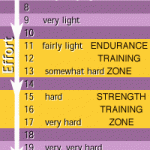 Ok…we talked about training zones and intensity…so the general idea is that the amount of effort gets a ‘label’…I’m including the chart again here so that you can click on it to get a bigger version…I’ve also included links throughout this post that refer back to further details in prior posts…if all you want is a laugh this morning just click here.
Ok…we talked about training zones and intensity…so the general idea is that the amount of effort gets a ‘label’…I’m including the chart again here so that you can click on it to get a bigger version…I’ve also included links throughout this post that refer back to further details in prior posts…if all you want is a laugh this morning just click here.
So, let’s look at the Moderately Hard Zone…going across the chart, you can see a number of ways that you can tell that you are training ‘moderately hard’…they are all the same thing…just different ways of determining how hard you’re ‘working’…the names are coaches that are widely published/quoted about the particular method…and approximated in the chart since they don’t really line up perfectly, but close enough for our purposes here:
- Heart Rate: 80-85% (of your maximum ‘TESTED’…not a guess based on a formula…Heart Rate…in each sport)
- RPE: Rate of Perceived Exertion: 13 on a Borg scale of 1-20)
- Joe Friel: Zone 3…on a scale of 1-5abc…also used by Coach Gale Bernhardt and the scale used as the ‘label’ for a lot of other methods
- Daniels: Tempo Pace: this is a precise running pace based on your vDOT, which is determined by testing
- Lydiard: 1/2 Effort
- Coggan: 76-90% of FTP (Functional Threshold Power)…Endurance Nation (EN) has their own slightly different ‘Zones’ that are quite a bit ‘narrower’ than the Coggan zones…like their Zone 3 on the bike would be 80-85% of FTP
 sooo, what does that all mean…well here’s how I use it:
sooo, what does that all mean…well here’s how I use it:
- for running I primarily use Daniels pacing chart based on my current 39 vDOT
- for biking I primarily use the Endurance Nation Zones as a percentage of my current 263 Watt FTP
- for swimming, pace based on a Threshold test…when I’m not just focusing on form…but a whole other topic, so I’ll focus on run and bike for today
I like these methods for their relative precision…all methods have some looseness to them, but the vDOT and FTP methods have the advantage of being typically based on a test that you’ve done to establish your maximum limits…or can be estimated from a race that you’ve done, or from hard workouts…like all methods there are detractors, but I like vDOT and FTP…a lot.
So when I’m doing running workouts, I do the fast sections on a track, so I know precisely what pace I’m running…and when I’m racing, I plan to run at a precise pace based on the race distance, and my current running fitness level, or vDOT…so real world, if my run workout has a Main Set of 2 x 1 mile at Tempo Pace, I know from my current 39 vDOT level that I run those at a 8:22/mile pace…done.
And when I’m doing a bike workout, I do the fast sections at the workout specification power level, based on the PowerTap power meter on my bike…similarly on the bike, if the workout spec for a particular day has a Main Set of 2 x 15 minutes at FTP Z4/5, that’s 95% of my current 263 Watts FTP, so 250 Watts…done.
…ok, it’s not always that exacting, but generally pretty close, unless I specifically dump out of the Intensity because it’s just not there in a particular workout…or if I’m feeling particularly strong and I let the Intensity leak up a little
 I use Heart Rate as a cross check to see if it’s in line with the harder numbers…this gives me somewhat of an indication of how tired I may be…if all is well, Heart Rate is in line with the Pace or Power zones…for me, if I’m worn out a bit, my Heart Rate is typically lower than it should be…or sometimes shoots up high…and this gives me an early indication in the workout that I may need to cut back the Intensity a bit…however Heart Rate, is an indirect indicator of ‘work’, and can be all over the place on any particular day on a bunch of other factors that have nothing to do with your training effort, so I’ve found it to only be a general, secondary indicator of ‘effort’ or ‘work’ that’s being done…my Heart Rate monitor also gives me distance, and pace while running, although the pace jumps around quite a bit, and more of a pain than just doing laps on the track.
I use Heart Rate as a cross check to see if it’s in line with the harder numbers…this gives me somewhat of an indication of how tired I may be…if all is well, Heart Rate is in line with the Pace or Power zones…for me, if I’m worn out a bit, my Heart Rate is typically lower than it should be…or sometimes shoots up high…and this gives me an early indication in the workout that I may need to cut back the Intensity a bit…however Heart Rate, is an indirect indicator of ‘work’, and can be all over the place on any particular day on a bunch of other factors that have nothing to do with your training effort, so I’ve found it to only be a general, secondary indicator of ‘effort’ or ‘work’ that’s being done…my Heart Rate monitor also gives me distance, and pace while running, although the pace jumps around quite a bit, and more of a pain than just doing laps on the track.
 And having said all that, RPE, or simply your Rate of Perceived Exertion has been shown in multiple tests to be eerily accurate…particularly in experienced atheletes…for me, since on any particular day, how stiff I feel, and even my mood or training motivation for the day, can impact my RPE…I only consider it as another level of cross check on how things are going…if the PowerTap says I’m pushing 250 Watts of power, I know that’s how much work I’m doing, irrespective of what I ‘think’ I’m doing, or what my Heart Rate is saying
And having said all that, RPE, or simply your Rate of Perceived Exertion has been shown in multiple tests to be eerily accurate…particularly in experienced atheletes…for me, since on any particular day, how stiff I feel, and even my mood or training motivation for the day, can impact my RPE…I only consider it as another level of cross check on how things are going…if the PowerTap says I’m pushing 250 Watts of power, I know that’s how much work I’m doing, irrespective of what I ‘think’ I’m doing, or what my Heart Rate is saying
…like if it’s very hot and humid out, and my Heart Rate is high Z4 and my RPE is a high 17, but I’m only at 200 Watts and struggling…my body didn’t get the benefit of a 250 Watt Z4/5 workout…I just didn’t do the ‘work’…Heart Rate and RPE were high in a losing battle to try to keep me cool, not support ‘work’ in the muscles…but another topic for another day 🙂
 So how valid are vDOT and FTP for you?…well, for running, I can’t really think of a reason to not establish, and train at specific paces instead of by Heart Rate or RPE. Other than not being in the mood to run an all-out 5K test (or longer…longer the better for Ironman), the only trick to it, is knowing how fast you’re really running in a workout. Where I live it’s all hills, all the time, so pace is all over the place, and that’s why I run over to the local college track, do the Main Set interval work there, and then on the hills aside from the fast intervals on the track, often revert to checking Heart Rate to keep in the Zone that I want…typically a Zone 1 or 2…if it was a Zone 3 or higher, I’d regard that as Intensity, and do the distance on the track.
So how valid are vDOT and FTP for you?…well, for running, I can’t really think of a reason to not establish, and train at specific paces instead of by Heart Rate or RPE. Other than not being in the mood to run an all-out 5K test (or longer…longer the better for Ironman), the only trick to it, is knowing how fast you’re really running in a workout. Where I live it’s all hills, all the time, so pace is all over the place, and that’s why I run over to the local college track, do the Main Set interval work there, and then on the hills aside from the fast intervals on the track, often revert to checking Heart Rate to keep in the Zone that I want…typically a Zone 1 or 2…if it was a Zone 3 or higher, I’d regard that as Intensity, and do the distance on the track.
 In terms of the bike, you need a Power Meter to tell you how much power you’re generating on an instant basis, and most aren’t cheap…but other than that, I can’t think of a reason to not train with power over the other methods…and hills don’t bother training with power…in fact it’s a huge advantage…training with power has nothing to do with speed, or headwinds…you just dial in your effort to the constantly updated little power number on the meter on your handbars…uphill or down…250 watts is still 250 watts…easy.
In terms of the bike, you need a Power Meter to tell you how much power you’re generating on an instant basis, and most aren’t cheap…but other than that, I can’t think of a reason to not train with power over the other methods…and hills don’t bother training with power…in fact it’s a huge advantage…training with power has nothing to do with speed, or headwinds…you just dial in your effort to the constantly updated little power number on the meter on your handbars…uphill or down…250 watts is still 250 watts…easy.
…and I could spend at least another couple of pages discussing the minutia of my summary here, and all the different methods, and their pro’s and con’s, but there are millions of pages on the Internet on the topic already, so I won’t add unnecessarily to that volume 🙂
…so when it comes to racing same thing…the ‘numbers’ tell me that my target potential on the bike in the Ironman is 70% (now 184 Watts) and Half Ironman at 80% (now 210 Watts) of my 263 Watt FTP… and running potential in Ironman at Daniels ‘Easy Pace’, which is now 10:23/mile, and my Half Ironman at Daniels ‘Marathon Pace’ 8:57/mile
…_lots_ of other factors in racing, but it’s nice to have a specific plan based on training experience, and what I _know_ that I can do, not on what I-think-that-maybe-I-can-do
At least that’s the plan 🙂

5 Responses to How I determine training intensity during a workout